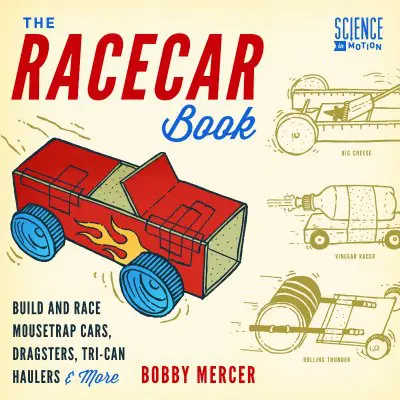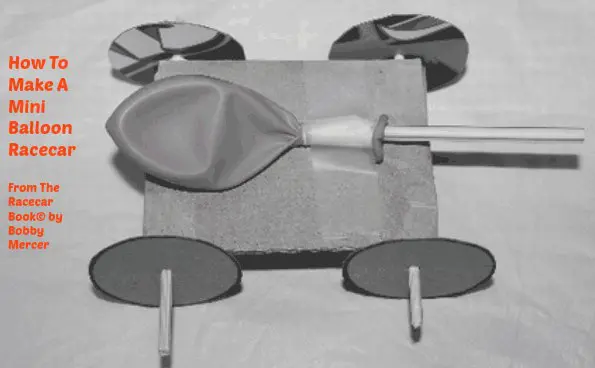I am so excited today to share with you an excerpt from The Racecar Book: Build and Race Mousetrap Cars, Dragsters, Tri-Can Haulers & More (Chicago Review Press, October 2013, Ages 9 & Up) by Bobby Mercer. I received permission from The Racecar Book by Bobby Mercer to reprint this excerpt on how to make a mini balloon racecar because I know that building is always fun for kids! Plus it is great for them to work on following directions, figuring out how things work, and creating something that will give them a sense of pride. This book teaches you how to make dozens of unique vehicles crafted with household items and recycled material such as old CDs, cereal boxes, candy bars, bottle caps and chip cans. The Racecar Book outlines age-appropriate physics lessons about friction, potential energy and traction in simple, age-appropriate language throughout.
Mini Balloon Racecar Experiment
Want a cool experiment for kids that will demonstrate Isaac Newton’s third law of motion in a hands on way? This Balloon race car is perfect for the job!
Rolling Gear:
- Cardboard
- Pen
- Small circular object
- Scissors
- Straw
- Tape
- Balloon
- 2 bamboo skewers
Please Note: The actual book includes a photo for each step. I only included the photo of the finished product at the end though.
Balloon Race Car Directions
Step 1: Trace around a small (about 2-inch) jar lid or other circular object on a scrap piece of corrugated cardboard. Trace 4 circles.
Step 2: Use scissors to cut out the wheels. Cut along the outside of the line to keep the wheels perfectly circular. Cutting the cardboard into 4 smaller sections before the final trim may be helpful.
Step 3: Use the point of the scissors to create a tiny hole in the center of each wheel. Unfold the scissors and spin the point into the cardboard. Use a piece of scrap cardboard under the wheel to avoid marking the table underneath.
Step 4: Cut out a 3-inch-by-4-inch piece of cardboard. It is easiest to cut along one corner of the cardboard for at least one side. The dimensions can vary slightly based on your cardboard piece.
Step 5: Cut two pieces of straw slightly wider than the short side of the car base.
Step 6: Tape two pieces of a drinking straw across the front bottom. Repeat across the rear bottom of your car base.
Step 7: Blow up a balloon and let it deflate four or five times. Stretching the rubber makes it easier to blow up each time. Insert a 6-inch piece of straw into the balloon neck. Wrap tape around the neck to seal the balloon. You should be able to blow up the balloon through the straw without air slipping out.
Step 8: Insert the pointed end of a bamboo skewer through the small hole in the center of the wheel. Slide the first wheel over about 4 inches.
Step 9: Slide the pointed end through one straw on the base of your car. Slide another wheel onto the pointed end. It helps to twist the skewer as you do this.
Step 10: Use the scissors to cut the skewer about ½ inch outside of the wheel. The scissors will probably just score the skewer, but it will break easily at that score.
Step 11: Repeat for the pointed end of the skewer. Repeat Steps 8 through 11 for the other wheel-axle combination.
Step 12: Tape the neck of the balloon to the cardboard base. Make sure you let the straw hang over the end and beyond the wheels. This makes it easier to inflate.
Step 13: Your Mini Balloon Racecar is ready to race. Blow up the balloon through the straw and pinch the straw closed. Set the car on the ground, release the straw, and let it ride.
Conclusion
The Mini Balloon Racecar works because of Isaac Newton’s third law of motion: for every action, there is an equal and opposite reaction. The air rushing out is the action and the car rolling in the opposite direction is the reaction. Also, watch the car really speed up as it loses air because it is getting lighter. Try different size and shape balloons to see which works best.
This mini balloon racecar chapter excerpted with permission from The Racecar Book by Bobby Mercer. © Chicago Review Press 2013. @IPGBookNews Available in book stores and online retailers nationwide October 1, 2013. Available through my affiliate Amazon link.
As you can tell, the Racecar Book has step-by-step instructions and helpful photographs accompany each project, making them ideal for science fairs and rainy days alike. Teachers, parents and kids will enjoy working together to safely make racecars and race them!
Related Posts:
How To Make Aromatherapy Stress Relieving Balls



tymarion says
what in the world do you need to make it roll?
Scarlet says
The wheels (bottle tops work well) allow it to roll and the air in the balloon provides the propulsion to move forward.